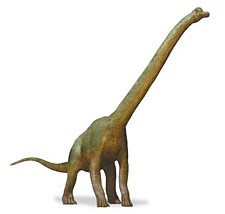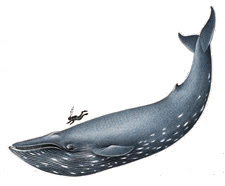 If you’re a palaeontologist you’ve heard this question a thousand times. And if you’re not a palaeontologist you might wonder why you never get the same answer twice. Well you see the annoying part of palaeontology is that the most spectacular animals are sometimes only known from a single bone or sometimes a fragment of a bone and so ‘reconstructing’ that animal can be incredibly difficult (and controversial).
If you’re a palaeontologist you’ve heard this question a thousand times. And if you’re not a palaeontologist you might wonder why you never get the same answer twice. Well you see the annoying part of palaeontology is that the most spectacular animals are sometimes only known from a single bone or sometimes a fragment of a bone and so ‘reconstructing’ that animal can be incredibly difficult (and controversial).
The famous French naturalist, Georges Cuvier once said
"Today comparative anatomy has reached such a point of perfection that, after inspecting a single bone, one can often determine the class, and sometimes even the genus of the animal to which it belonged, above all if that bone belonged to the head or the limbs. ... This is because the number, direction, and shape of the bones that compose each part of an animal's body are always in a necessary relation to all the other parts, in such a way that - up to a point - one can infer the whole from any one of them and vice versa."
 This principal is key to the reconstruction of many giant sauropods, which are often found as disarticulated, isolated specimens and historically, estimates of their size have varied dramatically. The other day, my nephew, Ben and I were debating whether sauropods were the largest animals that ever lived on Earth. Ben felt very strongly for the ‘for’ side while I was in the conservative camp of ‘against’ because I thought that while sauropods came close, they did not exceed the size of Blue Whales (about 30-33m long and 150-170 tonnes). Well according to Ken Carpenter's most recent estimate, pictured below by Matt Celeskey, Amphicoelias fragillimus may have been an amazing 58m (190ft) long! If you want to read more about how this estimate was made, visit Matt's wonderfully entertaining blog, the Hairy Museum of Natural History.
This principal is key to the reconstruction of many giant sauropods, which are often found as disarticulated, isolated specimens and historically, estimates of their size have varied dramatically. The other day, my nephew, Ben and I were debating whether sauropods were the largest animals that ever lived on Earth. Ben felt very strongly for the ‘for’ side while I was in the conservative camp of ‘against’ because I thought that while sauropods came close, they did not exceed the size of Blue Whales (about 30-33m long and 150-170 tonnes). Well according to Ken Carpenter's most recent estimate, pictured below by Matt Celeskey, Amphicoelias fragillimus may have been an amazing 58m (190ft) long! If you want to read more about how this estimate was made, visit Matt's wonderfully entertaining blog, the Hairy Museum of Natural History.

Left back: Amphicoelias fragillimus - estimated to be 58 m (190 ft) long
Left front: Seismosaurus hallorum - 33m (110ft) long
Middle: Human, Homo sapiens - 1.8m (6ft) tall and African Elephant, Loxodonta africana - 4m (13ft) tall
Medial right: Argentinosaurus huinculensis - estimated 30m (98ft) long
Furthest right: Puertasaurus reuili - estimated at least 35m (115ft) long
Sarda Sahney is a researcher at the University of Bristol and regularly posts on evolution, palaeontology, current controversies, biodiversity and conservation on her original site, http://fishfeet2007.blogspot.com.




Comments